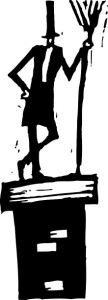A Look at Inspections
What To Expect From A Chimney Inspection
If you’re new to fireplace or stove and chimney ownership, the regular maintenance process may be a little daunting, since there’s a lot to think about, and the words “fire hazard” aren’t exactly soothing. You also may be picturing the soot-covered, ash dust-spewing chimney sweeps from the movies coming into your home with a sack of ratty brushes.
Regular chimney maintenance — particularly your annual chimney inspection — is important, both to ensure that your chimney system performs correctly, and performs as safely as it can. But when you hire the experienced, CSIA-certified technicians at Weststar Chimney Sweeps, it’ll be an easy, comforting and clean process, and we promise you won’t see a single sooty top hat.
When Weststar Techs Visit For A Chimney Inspection:
First things first: Our techs protect your home. We’ll lay dropcloths all around the work area to ensure that no mess is left.
Before we perform a standard chimney inspection (what’s considered a Level 1 inspection in the National Fire Protection Association’s 211 standard), we’ll sweep the chimney, to make sure creosote and debris is removed and we can get a clear and clean look at the flue and the rest of the system.
Once the chimney is clean, we’ll inspect every accessible part of the interior and exterior, from the firebox up to the chimney cap, looking for damage that could cause leaks or fire hazards. When we’ve completed that process, we’ll have a clear understanding of the state of your system, and you’ll have a report outlining all our findings, including any recommendations for repairs or replacement, so you can make informed decisions about next steps, if they’re necessary.
When A More Thorough Inspection Is Necessary
There are a few instances when a more detailed inspection — or a Level 2 inspection — will be more appropriate. One is when your chimney system has changed (like adding a new appliance or flue liner); another is when a property is being bought or sold. If this is your first chimney inspection, there’s a good chance it’s because you’re about to buy a house, so Level 2 is likely what you should inspect.
The process covers everything included in a basic visual inspection, but adds parts of the chimney that are in basements or crawl spaces and attics, and video scanning, which offers a much more detailed look at the flue. And that detail is really important if you’re about to take on a chimney system as your own — we all want to know exactly what we’re buying when we make a major purchase, and a Level 2 inspection insures that you get the full picture.
If you have any questions about chimney inspections or any other kind of chimney care, Weststar is always here to help — just give us a call!


